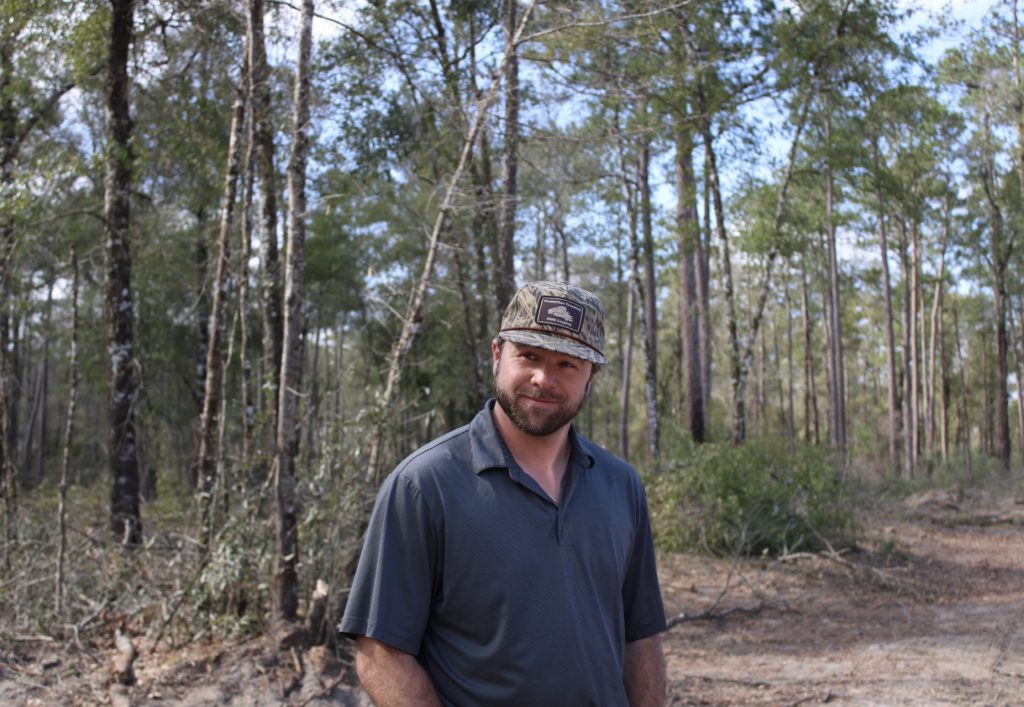
Story by Alice Ann Hollingsworth
The McInnis family in Greene County, Miss. has been ingrained in the timber tradition for generations. Standing at the forefront is Dillon McInnis, a man who not only oversees the family’s timber operations but is also deeply passionate about the land on which he works.
“I love the woods. I spend every day in them, and, yes, we cut trees down, but right here in Mississippi, we’re just farmers,” McInnis said. “While we’re growing that crop of trees … we try to help the wildlife (and) try to promote air and water quality.”
The McInnis family has owned and operated D&R Logging, Inc. and Timberline Trucking, Inc. since 1982. The company employs about a dozen workers and another 20 subcontractors.
McInnis said he and his company aim to be environmental stewards of the forest.
“Through the Mississippi State Extension Service, all of our loggers have received some training on best management practices,” McInnis said.
The sustainable approach to logging includes conducting controlled burns and selective planting. These methods not only support the timber industry but also enhance the habitat for wildlife, including game and endangered species, and foster a balanced ecosystem.
But the timber industry faces significant challenges, including the threat of pine beetles, the impacts of drought and the aftermath of natural disasters like tornadoes.
Christine Fortuin, an assistant professor in the Mississippi State University forestry department, studies the toll that catastrophic weather events can take on forests in the South.
“We are, as you know, seeing increases in the intensity of storms,” Fortuin said. “So the intensity of windstorms, of tornadoes, of hurricanes, of all those things — those kinds of events can really have a severe impact on forests.”
Fortuin considers the winds generated in these situations to be the largest climate-related threat to Mississippi’s forests, and she wants to help landowners do something about it.
“I started with developing some models of tornadoes and hurricanes in Southern forests to begin to predict what the effects are going to look like,” Fortuin said.
From there, Fortuin hopes to look at what variables give a forest more resilience to climate change.
“Hopefully, we can get a lot more specific about wind events and planting densities and timing and that sort of thing to help landowners make better plans to mitigate those kinds of potential catastrophic impacts,” Fortuin said.
McInnis said climate change is not a large concern for him right now.
“I’m not sold on climate change. I’m not denying it either by any means, but I think if there’s something happening it is going to be long term,” McInnis said. “I think it’s moving so slow that we haven’t seen it here.”
What does cause him worry is the economic landscape with high insurance costs and market dynamics that often leave logging companies bearing the brunt of price fluctuations. Even when the price of lumber increases, McInnis said logging companies do not necessarily make more money.
McInnis shared healthier markets will ultimately result in healthier forests. Although the demand for wood products rose significantly during the pandemic years, McInnis said sawmills reap the profits from this increase rather than landowners and logging companies.
With more than enough supply of lumber, the mills can set raw timber prices low.
“We have tons of wood growing in South Mississippi in this area right now,” McInnis said. “We’re outgrowing what the mills are using. So we need a little bit more of a place to consume the products.”
The introduction of government-funded carbon credit programs — a new development in the industry — presents both opportunities and challenges for loggers.
While aimed at promoting carbon sequestration — the process of capturing and storing carbon dioxide found in the atmosphere — these programs can impose restrictions that McInnis said may inadvertently hinder sustainable forestry practices.
McInnis voiced concerns about the overall health of forests if these programs limit essential activities like thinning, which is crucial for biodiversity as well as forest resilience.
Fortuin said that Mississippi is already doing quite well with carbon uptake, which is the amount of carbon dioxide produced versus that which is removed from the atmosphere.
According to the 2023 National Climate Assessment, Mississippi is at the top of all 50 states in terms of carbon uptake, thanks primarily to the state’s forests.
Mississippi’s forestry industry continues to evolve with improvements in management practices that address soil erosion and enhance the overall health of the forests. It is a source of pride for many, including McInnis, who cherishes the opportunity to work alongside family and friends in a business that’s not only a livelihood — but also a legacy.
Related Stories:
